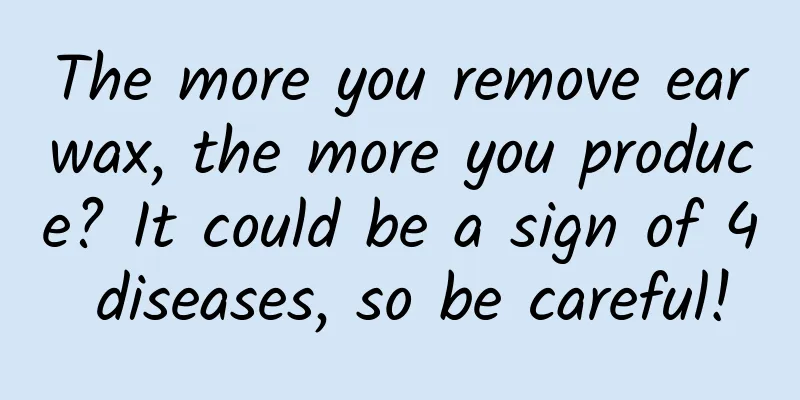The more you remove earwax, the more you produce? It could be a sign of 4 diseases, so be careful!

|
Recently, the topic of ear cleaning has frequently been on the hot search list, with topics such as #Never use your little finger to clean your ears# and #I didn't expect that the more you clean, the more earwax you will get# triggering widespread heated discussions among netizens. Since everyone is so interested in this, let’s talk about this useful “shit” today and talk about things about cleaning your ears. The so-called earwax, also known as cerumen, is a normal metabolic product secreted by the cerumen glands in the skin of the external auditory canal. It is a substance secreted by normal glands in the human body. Its main components are keratin, alcohols, fatty acids, dust and dandruff. Earwax can be divided into dry and wet types. Generally speaking, earwax is dry and yellowish in color. As it dries in the air, it forms thin, loose flakes and can be discharged into the external auditory canal through normal movements of the human body such as opening the mouth, chewing, and swallowing. It can usually fall off on its own. Some people have more abundant and sticky oil secretion, which is what we commonly call oily ears. When the ears are oily, the earwax is thicker and more likely to form clumps and cause earwax plugs. After earwax embolism, it will block the external auditory canal, causing external otitis, ear congestion and other discomforts. Therefore, if earwax embolism occurs, you need to go to the hospital and have a professional doctor remove the earwax. In summary, it is generally recommended that you deal with dry earwax yourself regularly, while it is recommended that you go to the hospital to let the doctor regularly use a suction device to absorb oily earwax, as it is not easy to remove it cleanly by yourself. 01 Earwax is useful “shit” Although the whole internet is digging and digging now, you should never dig your ears casually, and don’t always think about giving your ears a “health check-up”. You must remember that earwax is useful “shit”, so don’t “eliminate it completely”! Earwax is a secretion of the skin and a product of evolution. It has its own purpose, just like sweat cools down and moisturizes the skin. First of all, it has a defensive effect. Earwax in sheets or piles can effectively prevent flying insects, cockroaches, etc. from entering the deep part of the external auditory canal and damaging the eardrum. Especially outdoors and at night, it is a good barrier. Secondly, since earwax is secreted by sebaceous glands and has a certain oiliness, it can play a role in lubrication and moisturizing. It can not only protect the skin of the external auditory canal from being too dry and infected by fungi, dust, etc., but also form a hydrophobic layer to protect the skin when water enters the external auditory canal. Third, earwax is acidic and can maintain the normal pH balance of the external auditory canal. In clinical practice, some studies have shown that acute and chronic external otitis and fungal external otitis are not caused by infection, but mainly by changes in the acidic environment of the external auditory canal. The fundamental treatment measure is to restore the acidic environment of the external auditory canal. 02 Does earwax really increase the more you remove it? Many people enjoy picking earwax. They always feel that their ears are not clean. If they don't pick them for a day, they feel like something is missing, and they feel uncomfortable all over. Their ears feel itchy and uncomfortable. Is it true that the more you remove earwax, the more it will appear? Why do ears itch when you don't remove it? Generally speaking, earwax will not increase the more you dig it out! Earwax grows in a cycle and it won't grow more the more you remove it. However, if the following four situations occur, earwax may increase: 1. Chronic otitis externa. In this case, due to chronic inflammatory stimulation in the ear canal, ear canal secretions will continue to increase, which is a pathological manifestation. 2. In case of external auditory canal eczema, especially chronic eczema, a large amount of yellow crust-like secretions will be produced in the ear canal, which is thought to be earwax. 3. When a cholesteatoma grows in the external auditory canal, it was initially thought to be earwax, but it was eventually discovered to be a cholesteatoma scab formed by the continuous growth of the cholesteatoma. 4. Chronic suppurative otitis media, long-term pus discharge in the ear canal, and the pus crust is mistaken for earwax. 03 How to clean your ears correctly? Under normal circumstances, a small amount of earwax has a certain protective effect in the external auditory canal and is a favorable factor in maintaining the normal function of the external auditory canal. Therefore, there is no need to emphasize cleaning the external auditory canal particularly clean. However, when earwax completely blocks the opening of the external auditory canal, or causes hearing impairment or pain, earwax needs to be removed. The correct principles for cleaning your ears are: slow and gentle, and don't clean too deep. The simplest method is to use cotton swabs and ear spoons to simply deal with smaller earwax, but be careful not to use hard objects to remove earwax, otherwise it will damage the external auditory canal and thus damage the external auditory canal's own cleaning function. Under no circumstances should ear cleaning cause pain to the external auditory canal. If you feel pain in the external auditory canal when cleaning your ears, or some people even experience bleeding in the external auditory canal, it must be because you are cleaning too hard or too deep. If you dig too hard, it is especially easy to cause damage to the skin of the external auditory canal, which may lead to external otitis or external auditory canal bleeding. If you dig too deep, it may damage the eardrum, causing myringitis or perforation of the eardrum, which may lead to hearing loss. If there are large pieces of earwax, you can consider using sodium bicarbonate to drip or soak your ears first. If the earwax is not particularly large, it will mostly melt on its own. If you have oily ears, that is, the earwax secreted by the cerumen glands in the external auditory canal contains a relatively high oil content. These earwax will be more firmly attached to the wall of the external auditory canal. This type of people should pay attention to regular ear cleaning, and be slow and gentle during the cleaning process. If the amount of earwax is large or it is for children, you can go to the ENT clinic to flush the external auditory canal to remove the earwax. If you find that earwax is blocking the external auditory canal and it may not be easy to completely remove the earwax by yourself, you can go to the ENT clinic to have the doctor clean the external auditory canal. If the earwax is hard or deep and cannot be treated by flushing the external auditory canal, an otoscope is required. The otoscope is a modern instrument that can fully and clearly see every corner of the external auditory canal. The suction device can be used to remove all the earwax in the ear, and the external auditory canal can also be cleaned and treated locally, thus effectively preventing damage to the external auditory canal. 04 What should I do if I bleed when I pick my earwax? If you accidentally break the ear canal membrane while cleaning your ears and bleeding occurs, don't worry too much. The amount of bleeding is generally not too much. You can stuff toilet paper or cotton balls into the ear canal opening. This mainly serves to compress and stop bleeding, and can also prevent dirty water or dirt from entering the patient's ear canal and causing infection. The patient can remove the blocked material after one hour, and a blood clot may form in the ear canal. Over time, a blood scab will slowly form. The important thing is that you must not clean out the blood clots in advance, as this may cause the ear canal mucosa to bleed again; at the same time, you must also prevent water from entering the ears or using ear drops, and use antibiotics for treatment if necessary. 05 How often is it best to remove earwax? Ordinary people: There is no fixed time interval for earwax cleaning. It is usually not recommended to clean earwax frequently because earwax will fall off and be discharged from the external auditory canal on its own. If the earwax is cleaned too thoroughly, it will make the skin of the external auditory canal susceptible to infection and the formation of boils. Special populations: For patients with active cerumen gland secretion, earwax can easily block the external auditory canal, or oily earwax can form oily ears, causing earwax to accumulate in the external auditory canal and be difficult to discharge. It is recommended that such people go to the ENT clinic to clean the external auditory canal every 3-6 months. Source of this article: pexels (delete for infringement) |
>>: Can we keep a dinosaur in the modern world?
Recommend
Ningxia College Entrance Examination Score Line 2020 [First and Second Score Line Released] 2020 Ningxia College Entrance Examination Score Line List
Ningxia College Entrance Examination Score Line 2...
How can programmers quickly get promoted and get a raise at the beginning of their careers?
In a mature medium or large organization, profess...
Dong Mingzhu plays up internet celebrity marketing, but consumers don't seem to be interested
Gree's Sejie mobile phone, which was launched ...
Faced with constant pessimism, why have new car manufacturers such as NIO ushered in historic opportunities?
NIO successfully went public in the United States...
An unexpected result of technological evolution: How did games and cryptocurrencies become the “computing power base” of AI?
In the past spring, we witnessed the largest tech...
Fan Deng Reading User Growth System!
Fan Deng’s annual revenue from reading books has ...
Urumqi WeChat ordering software mini program, how much does the catering WeChat mini program cost?
Everyone is familiar with WeChat mini-programs . ...
Staying up late because of the epidemic? You will regret it someday!
With the frequent outbreaks of the epidemic, have...
How to master Metaverse Marketing? 4 key points!
The hottest concept in the past year is undoubted...
Don’t be angry or anxious! These skin problems that damage your appearance are all psychologically related.
A suggestion for everyone Be happy now! Image sou...
Brand marketing promotion: Analysis of Marvel IP’s brand positioning strategy!
To be or not to be? That is the question. There a...
7 Ways to Use Mobile Game Analytics Data Properly
Knowledge is power, which is especially important...
How can community operations be converted from 0 to thousands of users?
Why is no one joining my community? Why can't...
The city sewers have become a crocodile dungeon? They also stole the camera... Can this be considered a good thing?
In the comics, some teenage turtles live in the s...
Vivian 28-day sales training camp, how much does Vivian sales course cost?
Throughout my career, I have been involved in sal...


![[Popular Science of Chinese Military Technology] How did China's legendary sniper become what it is today?](/upload/images/67f250a2d6781.webp)






